
Lafarge is implementing a worldwide initiative to optimise drilling and blasting operations across its 600 sites globally. The initiative aims to reduce costs, increase safety, and lessen the impact on the environment. The potential savings have been estimated at €10-25 million annually.
Fragmentation has a large impact on quarry performance at every stage of the drilling, loading, and blasting process. The initiative therefore plans to increase awareness and understanding of fragmentation and implement best practices to reduce direct and indirect costs.
Best practices include the identification of experts, suppliers and equipment to improve the blasting process plus setting up procedures and ensuring competency of operators through training.
This is revealed in a recent case study that was put together by MDL (
It looks at the principles of successful blasting.
For blast design parameters it says the measurement, understanding, and use of accurate design metrics are very important for successful blasting. This should also include consultation with mining plans and a good understanding of the quarry geology.
Blast design pre-requisites include face preparation where benches must be cleared, scaled of loose rock, and inspected for condition before profiling and blasting, while under surveying, accurate bench profiling and surveying is the first stage in the manufacturing process and is critical to the efficiency of the remaining downstream activities. Key to this is the use of correct equipment and trained operators. Measurement of bench heights, level of crest and toe, slope angle, and maximum and minimum burden can be done using 2D and 3D laser profiling. By mapping a rock face in detail it is possible to determine actual burdens in front of each planned borehole to avoid excessive burden (vibration, oversize) and insufficient burden (flyrock, airblast). If neglected, or if surveying is done incorrectly, it can have a detrimental effect on the rest of the manufacturing process including poor quality drilling and mining operations with increased safety risks and cost.
Under blast design, the blast-hole layout should be designed with respect to the collected survey data and hence the accuracy and interpretation of this data is paramount. Safety parameters, vibration limits, explosives to be used, and design floor elevations must also be considered when designing the pattern. The resulting blast design plan should clearly specify the collar elevations, burden, spacing, drill-hole diameter, type and quantity of explosives and type and delay of detonators. The layout of the blast-hole pattern should then be set-out through the use of surveying instruments.
Drilling execution
Checking that the drilling is done correctly as per the blast design is very important including verifying the hole depth, diameter and inclination using accurate blast-hole geometry measurement equipment. Incorrect drilling including wrong positioning, incorrect angle, hole deviation, and incorrect depth can pose serious risks.
An explosives loading plan requires effective implementation and validation of the loading plan including the position of delays, charge, charge distribution, type and quantity of explosives, and stemming requirements.
In conclusion, the improvements gained from an optimised drilling and blasting operation can be measured by reduced costs per tonne for blasting and drilling, improved loading speeds, reduced oversize breakage and handling, reduced energy consumption and less fines.
The average measured saving from the pilot study across 12 sites is about four euro cents per tonne. Across Lafarge’s total aggregate and cement mined tonnes (250 million) this equates to €10 million savings annually. Lafarge is confident that further savings can be made through a rigorous optimisation process and is currently rolling out the system across the group.















